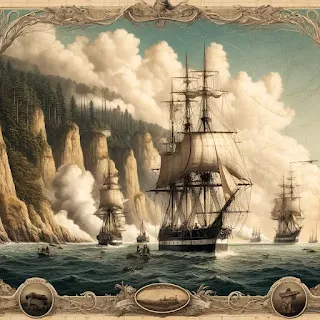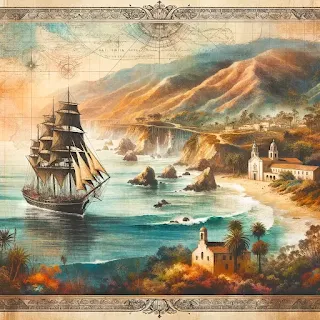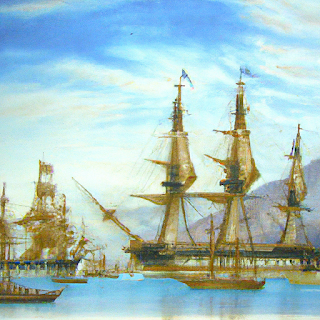Ships and Societies
The article discusses the preparations of four vessels in port for sea, including the Savannah, and praises the officers for their service in California. It reflects on the unique circumstances surrounding the conquest of California, highlighting the challenges faced by the American forces and the efforts of Commodore Stockton in pursuing a conciliatory approach. Overall, the article commends the officers for their actions and the success of the conquest with minimal loss of blood and treasure.
One of the most notable aspects of the article is its sentimental acknowledgment of the departing ships and their crews, particularly the **Savannah**, whose officers had established a strong rapport with the local citizens. The author writes, “It is with the kind of feeling which we should entertain for the departure of a brother, that we see them leave the coast,” suggesting a profound emotional connection developed between the military and civilian populations. This sentiment underscores the transient nature of military presence and the complexities of relationships forged during this era of territorial expansion.
The article proceeds to assess the challenges faced by military commanders in their efforts to administer a newly acquired and politically unstable region. It emphasizes the unprecedented nature of the officers' situation: “There was no precedent. No one had gone before, and the Commanders had of necessity to chalk out a path for themselves.” This acknowledgment of the uniqueness of California—a region marked by chaotic governance and a lack of established systems due to past revolutions—highlights the difficulties military leaders encountered in their attempts to instill order and promote American governance.
Furthermore, the article sheds light on the complex sociopolitical dynamics in California during this transition. The suggestion that the region might have sought protection from either the United States or Great Britain illustrates the delicate balance of power and the interests of various factions within the local population. The author notes, “A strong party was in favor of asking protection from the United States, and actually commenced making preparation for a formal request to that effect,” indicating that there were significant local divisions regarding allegiance, a fact that the American military had to navigate carefully.
The conduct of officers like Commodore Stockton is elaborated upon with a degree of ambivalence. While the author defends Stockton’s decisions amidst “unprincipled men” and assures readers that his actions were akin to those of great leaders like “Washington, or Jackson,” he simultaneously hints at the precariousness of their situation, evoking the complex realities of military rule in a territory with a cacophony of competing interests. The quote, “With such a mass of discordant materials our ‘Sailor General’ has done well for his country, and deserves great credit,” is a recognition of the challenges presented not only by the enemy but also by the diverse groups and the unfamiliar environment of California.
In summary, the article "GOINGS ON" acts as both a historical document and a reflection of the period's attitudes toward American expansionism, military leadership, and local governance. It captures the optimism of California's integration into the United States while remaining acutely aware of the labor and complexities involved. The blend of camaraderie, caution, and critique presents a nuanced view of a pivotal moment in American history. Such analyses of military and civilian interactions during this transformative time deepen our understanding of California's path toward statehood and its place within the broader narrative of American territorial expansion.
Navigating the Tides of History: The Departure of the USS Savannah and California's Transformation (1846-1848)
Moments of transition throughout history often carry profound significance, hinting at the larger tides of change that shape a nation’s identity. One such pivotal moment unfolds in a brief, yet poignant article from “The Californian” newspaper, published in 1846. Titled “GOINGS ON,” the article details the departure of key vessels from a California port, with particular emphasis on the USS Savannah. Set against a backdrop of political shifts, military actions, and the burgeoning influence of American governance in California, this narrative invites us to explore how the relative calm enveloping this departure belies a much more intricate and turbulent series of developments that would ultimately shape California’s enduring legacy.
The Context of Maritime Activity: Ships and Societies
As we delve into the article, we are greeted with a vibrant depiction of the bustling maritime scene at the port. “Four of the vessels in port have been preparing for sea,” it asserts, capturing not just the immediate activity but also hinting at the broader implications of these departures as California evolved from a territory brimming with potential into an integral part of the American union. Among these vessels, the USS Savannah stands out—not merely as a ship, but as a symbol of the American Navy's growing presence along the Pacific coast.A Farewell to the Savannah
The farewell to the USS Savannah resonates deeply, evoking feelings akin to bidding adieu to a close friend. The article states, “It is with the kind of feeling which we should entertain for the departure of a brother that we see them leave the coast.” This emotional reflection is crucial for understanding the dynamics between military and civilian relationships during such a turbulent time. Captain Mervine, the commander of the Savannah, emerges as a key figure in the early narrative of American governance in California. His presence marked the moment when the American flag was first hoisted on the Pacific, making his departure not only a personal loss for Californian citizens but also a moment laden with meaning about the aspirations and uncertainties that lay just beyond the horizon.The Complicated Legacy of California's Governance
As we explore further, it becomes evident that Mervine's leadership encapsulates broader challenges faced during this period of military occupation and nascent governance in California. The article acknowledges the complexity of leadership in stating that while Mervine might have erred, “if he has not erred, it is a strong evidence of their superior judgement.” This reveals a nuanced understanding that military leaders operated amidst unprecedented circumstances, navigating conflicting interests as they forged paths through uncharted waters.The Complications of "Conquest"
This acknowledgment of California's tumultuous past reflects deeper socio-political issues at play. The text notes, “California was a disconnected province... subject to constant revolution and changed at the will of every ambitious politician.” Here, the narrative captures California’s precarious status as a region on the fringes of governance—perpetually influenced by uncertainty and internal strife. The idea that California was ultimately “offered” to the United States by default underscores a crucial aspect of imperialism, where national borders were redefined more out of necessity than by popular consent.An emerging consciousness among Californians, who began contemplating a shift in allegiances from a crumbling Mexican authority to the emerging American governance, is palpable. The article notes, “A strong party was in favor of asking protection from the United States,” while others sought favor with Great Britain. This fragment of discourse unveils the precarious geopolitical position of California during this era. Here was a place where multiple powers vied for control, reflecting broader trends of colonial expansion and post-war reconfigurations.
The Role of Military Leadership
Turning our attention to military leadership, we see that the article devotes significant space to discussing the actions of Commodore Stockton and other military figures who faced the formidable task of managing this delicate transition. Stockton’s “most conciliatory measures” were pivotal in maintaining stability within what could easily have devolved into chaos, illustrating the strategic thinking necessary during a period where military might intertwined with diplomatic tact. Each leader had to carve out their approach, as traditional colonial methods of governance confronted the realities of local dynamics and sentiments.The Distributed Responsibility of Governance
This narrative introduces the idea that California's governance was not the solar product of any singular military strategy, but rather a confluence of impulses from multiple factions—both military and civilian. Soldiers who “arrived… entirely without discipline” underscore the urgent yet haphazard efforts at governance. The diverse backgrounds of these troops—depicted as “a mass of discordant materials”—suggest that the military presence in California represented both an experiment in governance and a display of force.The complexities inherent in integrating these varied groups into a cohesive governing body further illuminate the obstacles confronted by leaders like General Kearny. The article concludes that, “with but one army officer,” Kearny’s disciplined troops demonstrated an extraordinary feat of adaptation amid ambiguity. Thus, for California, the actions of military leaders during this period were not merely about conquest; they were about establishing the foundational identity of governance that would influence generations to come.
Californian Society and Its Aspirations
As we navigate deeper into the intricacies of Californian society, a glaring tension emerges: the struggle for self-governance amidst pervasive external control. The assertion that “sufficient time has not yet elapsed for society to become fixed upon any regulated system” paints a dire picture of societal instability, underscoring an urgent need for a structured governance approach. With the specter of revolution and discontent simmering just below the surface, the ambiguities of authority fostered both advocacy and opposition in equal measure.An American Identity Takes Shape
The allegiance of many educated Californians to the American cause speaks volumes about the complex evolution of national identity during this time. The article notes that “with very few exceptions, the educated and influential Californians have remained well disposed towards the American cause.” This assertion underlines the aspirations of many Californians who saw their futures intertwined with an evolving American identity, even as they grappled with the inconsistencies and challenges of early governance.Simultaneously, the article emphasizes the importance of leadership that remains attuned to local sentiments. The mention that “the new governor is disposed to pursue the most pacific policy” signifies a growing awareness of diplomacy as a vital element of governance—facilitating citizens’ transition into a deeper understanding of their evolving identity, with far-reaching economic, cultural, and political implications.
The Path Forward: Governance and Grievances
As we approach the conclusion of the article, it gestures toward the path forward, recognizing “many minor grievances, which we hope will soon be removed.” This acknowledgment of discord within the fabric of governance reveals an underlying tension; even amidst transformative military successes, the social fabric remained fraught with challenges that required resolution.The hope for addressing grievances related to governance reflects the broader arc of America’s ongoing efforts toward inclusivity, representation, and deliberation. This ambition encapsulates many of the struggles that continue to define American democracy—an evolving experiment shaped by the diverse voices of its population.
Conclusion: The Legacy of Departure
In summation, the departure of the USS Savannah and its surrounding narrative encapsulate the essence of a pivotal historical crossroads for California. The emotional weight of this farewell offers a richer understanding of the complex relationships between military forces and civilian populations, revealing a web of political maneuvering, cultural sentiments, and aspirations for self-determination.By examining this historical snapshot, we gain valuable insights into how the seeds of governance and identity were sown during this transformative period. Those early moments in California’s history—marked by military presence, societal anxieties, and heartfelt farewells—continue to resonate through the state’s modern identity.
The historical account of California serves as a vital reminder that the path to statehood is not solely defined by singular narratives of conquest but by a mosaic of collective experiences that shape our future. As we reflect on these interconnected threads, we cultivate a deeper appreciation for both the challenges and triumphs of navigating the tides of history. Ultimately, narratives like “GOINGS ON” serve as essential lessons in understanding our shared experience, weaving together the complex fabric of California's past and its role in shaping our present.
Key Phrases:
1. "USS Savannah and California's Transformation" - This relates to the historical significance of naval expeditions and their impact on regional governance. For further reading and research, see this article on the role of naval power in American history from [U.S. Naval Institute](https://www.usni.org/magazines/navalhistory/2020/february/role-naval-power-american-history).2. "Military leadership during California's governance" - This pertains to the complexities of military leadership and governance in newly acquired territories. For a deeper exploration of military governance in American history, refer to this study by [The California History Journal](https://www.californiahistorian.com/military-governance).
3. "California's societal instability post-conquest" - This highlights the social dynamics and instability amid political changes in California. An insightful resource on social upheavals during this period can be found in this article from [The Journal of American History](https://academic.oup.com/jah/article-abstract/95/4/865/780547).
4. "Impact of Commodore Stockton's conciliatory measures" - This emphasizes the strategies employed by military leaders to maintain stability. For further reading, explore the biography of Commodore Stockton at [National Park Service](https://www.nps.gov/people/stockton.htm).
5. "California's precarious status as a disconnected province" - This speaks to California's governance challenges during its transition from a Mexican territory. For insights on Cailfornia's transition during the Mexican-American War, refer to this paper published by [Stanford University](https://www.stanford.edu/group/colonialamericas/cmp/publications/California_transition.html).
6. "The role of military and civilian relationships during upheaval" - This focuses on interactions between military leaders and civilian populations, which are crucial for understanding governance. A relevant discussion can be found in this article on civil-military relations from [The American Political Science Review](https://www.cambridge.org/core/journals/american-political-science-review/article/civilmilitary-relations-and-the-role-of-armed-forces-in-democracy/86224BE6E4A3B640A5DAE0BB2E47E67F).
7. "Emerging American identity in California" - This reflects on the developing identity among Californians during a period of transformation. For an exploration of identity formation in the 19th century, consult this resource from [The American Historical Association](https://www.historians.org/research-and-publications/american-historical-review).
8. "Grievances in early Californian governance" - This highlights discontent with governance and the need for representation. A comprehensive analysis of governance issues can be reviewed in this article in [California History Journal](https://www.californiahistorian.com/grievances-in-statehood).
**Citation**: The Californian,
- GOINGS ON., 1847-03-20https://cdnc.ucr.edu/ University of California Riverside Digital Newspaper Archive








